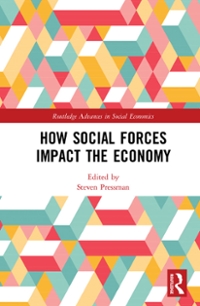Question
Consider two neighbouring island countries called Dolorium and Arcadia. They each have 4 million labour hours available per month that they can use to produce
Consider two neighbouring island countries called Dolorium and Arcadia. They each have 4 million labour hours available per month that they can use to produce corn, jeans, or a combination of both. The following table shows the amount of corn or jeans that can be produced using one hour of labour.
| Country | Corn | Jeans |
|---|---|---|
| (Bushels per hour of labour) | (Pairs per hour of labour) | |
| Dolorium | 8 | 32 |
| Arcadia | 12 | 24 |
Initially, suppose Arcadia uses 1 million hours of labour per month to produce corn and 3 million hours per month to produce jeans, while Dolorium uses 3 million hours of labour per month to produce corn and 1 million hours per month to produce jeans. Consequently, Dolorium produces 24 million bushels of corn and 32 million pairs of jeans, and Arcadia produces 12 million bushels of corn and 72 million pairs of jeans. Assume there are no other countries willing to trade goods, so, in the absence of trade between these two countries, each country consumes the amount of corn and jeans it produces.
Dolorium's opportunity cost of producing 1 bushel of corn is _(1/2 pair or 1/4 pair or 2 pairs or 4 pairs)_ of jeans, and Arcadia's opportunity cost of producing 1 bushel of corn is _(1/2 pair or 1/4 pair or 2 pairs or 4 pairs)_of jeans. Therefore, __(Arcadia or Dolorium)__ has a comparative advantage in producing corn, and _(Arcadia or Dolorium)__ has a comparative advantage in producing jeans.
Suppose that each country completely specializes in producing the good in which it has a comparative advantage, producing onlythat good. In this case, the country that produces corn will produce ____________ millionbushels per month, and the country that produces jeans will produce _____________ millionpairs per month.
In the following table, enter each country's production decision in the third row of the table (marked "Production").
Suppose the country that produces corn trades 26 million bushels of corn to the other country in exchange for 78 million pairs of jeans.
In the following table, select the amount of each good that each country exports and imports in the boxes across the row marked "Trade Action," and enter each country's final consumption of each good in the row marked "Consumption."
When the two countries did not specialize, the total production of corn was 36 million bushels per month, and the total production of jeans was 104 million pairs per month. Because of specialization, the total production of corn has increased by ___________ millionbushels per month, and the total production of jeans has increased by _________ millionpairs per month.
Because the two countries produce more corn and more jeans under specialization, each country is able to gain from trade.
Calculate the gains from tradethat is, the amount by which each country has increased its consumption of each good relative to the first row of the table. In the following table, enter this difference in the boxes across the last row (marked "Increase in Consumption").
| Dolorium | Arcadia | |||
|---|---|---|---|---|
| Corn | Jeans | Corn | Jeans | |
| (Millions of bushels) | (Millions of pairs) | (Millions of bushels) | (Millions of pairs) | |
| Without Trade | ||||
| Production | 24 | 32 | 12 | 72 |
| Consumption | 24 | 32 | 12 | 72 |
| With Trade | ||||
| Production | ||||
| Trade Action | Exports 26 or Imports 26 | Exports 78 or Imports 78 | Exports 26 or Imports 26 | Exports 78 or Imports 78 |
| Consumption | ||||
| Gains from Trade | ||||
| Increase in Consumption |

Step by Step Solution
There are 3 Steps involved in it
Step: 1

Get Instant Access to Expert-Tailored Solutions
See step-by-step solutions with expert insights and AI powered tools for academic success
Step: 2

Step: 3

Ace Your Homework with AI
Get the answers you need in no time with our AI-driven, step-by-step assistance
Get Started


